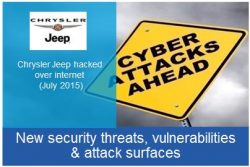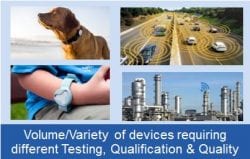The inaugural IoT Grand Slam 2016 Virtual Internet of Things Conference is focused on the following topics formed of the following tracks:
TRACK 1: Standards: Multiple initiatives which lack unification and ratification
 With the number and variety of IoT standards that have different design objectives and target applications, how does and should an IoT developer make sensible choices when they are architecting, designing and implementing their devices and applications. How can a developer test their implementation interoperates with other implementations and performs satisfactorily in the field, especially when deployed in large numbers and perhaps in hostile environment conditions. How can develop make their implementation as future-proof as their operating environment demands.
With the number and variety of IoT standards that have different design objectives and target applications, how does and should an IoT developer make sensible choices when they are architecting, designing and implementing their devices and applications. How can a developer test their implementation interoperates with other implementations and performs satisfactorily in the field, especially when deployed in large numbers and perhaps in hostile environment conditions. How can develop make their implementation as future-proof as their operating environment demands.
Experience from Developer perspective
o Positioning and rationalization of IoT Standards
o Development of standards-based IoT Devices and Applications
o Techniques, Methodologies and Best Practices for IoT Devices and Applications Design, Development and Testing
TRACK 2: Interoperability and Integration

Integration includes not only the infrastructure and foundational services, but must address data integration and then unification/management of datasets over time for the purpose of predictive analysis, search, real-time control, etc. Interoperability must be considered at the lowest ‘layers’ of data communications, the management/control plane as well as the data plane, and the smooth (and safe/secure) inter-working of systems that are under the distinct and separate management of different organizations.
Experience from a Practitioner perspective.
- Who needs or wants to work together? In what ways?
- What is required and desirable to enable the inter-operation or integration of these related applications or systems?
- What commercial and technical frameworks need to be in place? What is the impact going to be on the industry and the end-user consumer or enterprise?
TRACK 3: Security: Defending Applications, Pipes and End-points from Attack
 IoT security remains an ongoing challenge. Developers are confronted with ensuring their implementations are secure. How can developers ensure their implementations are successfully resilient against known vulnerabilities and future threats, as much as that is possible. How will their device and application work securely in the network and when interoperating with other systems.
IoT security remains an ongoing challenge. Developers are confronted with ensuring their implementations are secure. How can developers ensure their implementations are successfully resilient against known vulnerabilities and future threats, as much as that is possible. How will their device and application work securely in the network and when interoperating with other systems.
Experience from Network Operator perspective
o How can/should developers implement their devices and applications to easily connect and
o How are you addressing the volume and variety of connected devices on your network and operate on their networks and work across network operators? and how are your practices and procedures changing to meet the demands of IoT?
TRACK 4: Inexperience with Network Communications, Security and IT
 With IoT emerging in many applications segments, in such a wide range of functionality and complexity, the industry is faced with the challenged that many developers do not have as deep as experience in network communications, security and IT that mobile phone, smartphone and tablet developers have had in the past. How can a developer learn and adopt the best practices for their device, application or the networks to which their devices or application will be connected.
With IoT emerging in many applications segments, in such a wide range of functionality and complexity, the industry is faced with the challenged that many developers do not have as deep as experience in network communications, security and IT that mobile phone, smartphone and tablet developers have had in the past. How can a developer learn and adopt the best practices for their device, application or the networks to which their devices or application will be connected.
Experience from Enterprises and/or User perspective:
o What were the issues and challenges in implementing an IoT-based application and how have you realized the benefits IoT enabled?
TRACK 5: Volume and Variety of Devices and Applications
 Network operators have to ensure IoT devices can be simply, safely and securely connected to your networks such that the device can work satisfactorily, the network can offer the quality of service expected for the application, and the customer experience is satisfactory, whether the customer is a human or an application. With the large number and variety of devices and applications, operators have to develop systems to get devices connected to their networks quickly and use active techniques and analytics to verify the operation of the device and application, initially they are first connected, after some time as the number of devices on the network scales large. What are the key performance indicators or characteristics that determine if a IoT device is operating satisfactorily or abnormally.
Network operators have to ensure IoT devices can be simply, safely and securely connected to your networks such that the device can work satisfactorily, the network can offer the quality of service expected for the application, and the customer experience is satisfactory, whether the customer is a human or an application. With the large number and variety of devices and applications, operators have to develop systems to get devices connected to their networks quickly and use active techniques and analytics to verify the operation of the device and application, initially they are first connected, after some time as the number of devices on the network scales large. What are the key performance indicators or characteristics that determine if a IoT device is operating satisfactorily or abnormally.
Experience from Data Handling perspective:
o Applying analytics in large-scale IoT deployments
TRACK 6: In the Field for Long Periods and in Hostile Environments
 Many IoT devices and applications need to operate in the field for long periods of time and in hostile environments, characterized by harsh temperature, humidity and exposed to humans, animals and nature. How can an operator ensure the satisfactory operation over the expected lifetime of the device or application? Battery life is a serious challenge for many IoT devices and applications.
Many IoT devices and applications need to operate in the field for long periods of time and in hostile environments, characterized by harsh temperature, humidity and exposed to humans, animals and nature. How can an operator ensure the satisfactory operation over the expected lifetime of the device or application? Battery life is a serious challenge for many IoT devices and applications.
Experience from End-User perspective:
o Designing long-life IoT devices in a hostile/isolated environment
TRACK 7. Best Practices: Lessons Learned from putting IoT strategies into practice
 We will focus on sharing and learning from the experiences in developing, deploying and managing IoT-enabled systems and applications to understand the challenges and best practices to realize the high-impact benefits from IoT. For example, we anticipate we will explore how to put in place a data hub for your city, enterprise or community, and how to combine data in a useful, interconnected way to address infrastructure challenges. We will discuss the partnerships, projects and schemes major stakeholders are undertaking, and the lessons learned. We will explore the best ways to engage with IoT planners and solutions providers to establish the optimal means of partnership, and building on common commercial interests. We will explore the opportunities for companies looking to leverage IoT throughout their developments.
We will focus on sharing and learning from the experiences in developing, deploying and managing IoT-enabled systems and applications to understand the challenges and best practices to realize the high-impact benefits from IoT. For example, we anticipate we will explore how to put in place a data hub for your city, enterprise or community, and how to combine data in a useful, interconnected way to address infrastructure challenges. We will discuss the partnerships, projects and schemes major stakeholders are undertaking, and the lessons learned. We will explore the best ways to engage with IoT planners and solutions providers to establish the optimal means of partnership, and building on common commercial interests. We will explore the opportunities for companies looking to leverage IoT throughout their developments.
Practical Experience and Best Practices from Practioners (Developer, Operator, Enterprise &; User)
o Connecting and Operating IoT Devices and Applications
o Performance Challenges, Outlook and Best Practices for Scalable IoT
o Security Challenges, Outlook and Best Practices for Secure IoT
Tracks applied across the following topics (not limited to):
| IoT Enabler Topics | Enterprise IoT Topics | IoT Developer Topics | IoT Platform Topics |
|---|---|---|---|
| Sensors and data points. | Industrial / Enterprise Benchmarking | Applications and Platforms | Standards and collaboration |
| Devices and Appliances | Authentication and Security | Cloud and Storage | Soft Computing |
| Ubiquitous coverage and connectivity | Infrastructure and Processing | Evolving Standards | Swarm intelligence |
| Automation | Digital Transformation / Interoperability | Open Source Devices | Learning Software Organization |
| Wearables and Augmented Reality | Bandwidth and Pipe Availability | Managing end-point Communications | Platforms and portability |
| Microcontrollers | Big Data Analytics | Interoperability and validation | Software Architecture |
| Mobile Payments | Business Transformation | Prescriptive Analytics | Big Data Analytics |
| Near Field Communication | Commercial Viability | Ecosystems | Vertical Alignment and Customization |
| Regulations | Visualization | Development Environments | Mobile and Connectivity |
Join our IoT Community at https://www.linkedin.com/groups/4662022/profile
IoT Slam Virtual Internet of Things Conference

Back to home page


